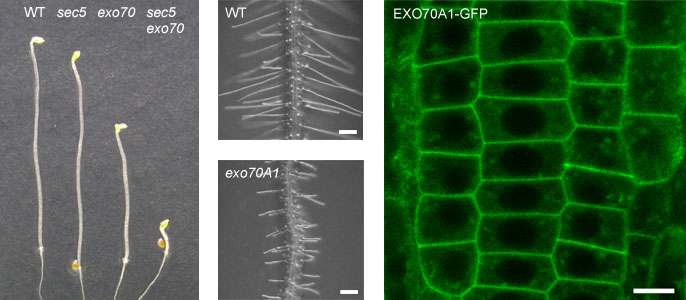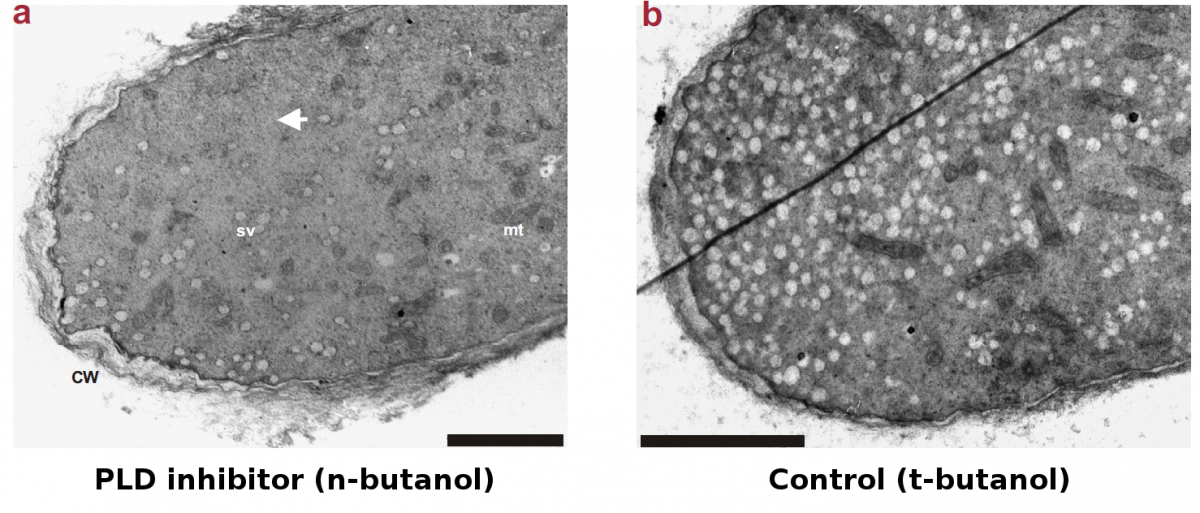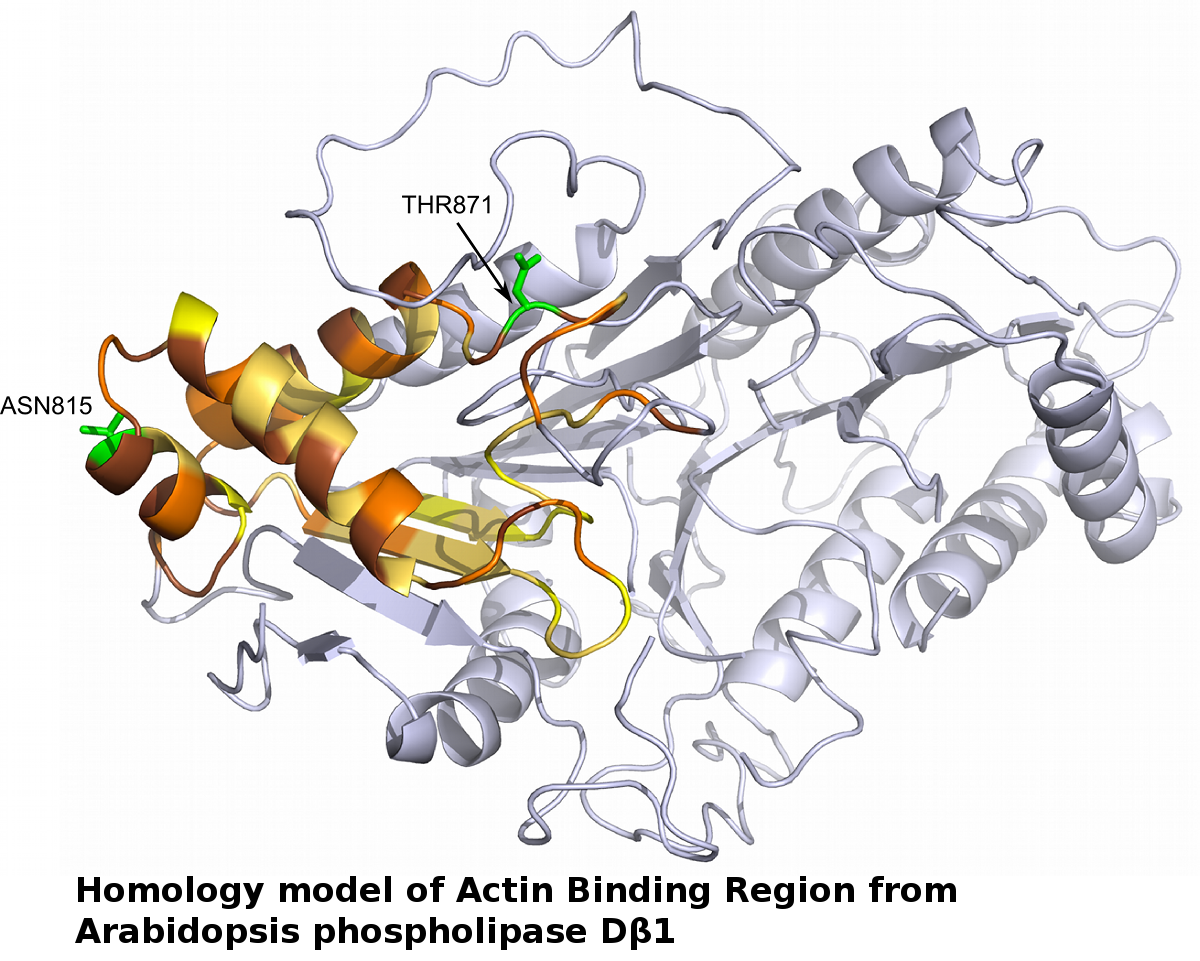Laboratory of Cell Biology
The Exocyst Complex in Regulation of Cell Morfogenesis and Pathogen Defence
Cell morphogenesis and related regulatory processes in plant cells are the dominant field of interest in our laboratory. Plant morphogenesis results from two processes - oriented cell division and differential cell growth. We focus on intracellular molecular mechanisms driving cellular morphogenesis such as exocystosis. Proteins participating in these mechanisms are, despite of the major differences in cell structure and behaviour, often very similar to those found in the fungal and animal kingdoms (Žárský and Cvrčková, 1997; Cvrčková et al., 2001).
One of elements regulating exocytosis is the exocyst, an ancient protein complex generally found in eukaryots. The exocyst serves as an effector of RAB and RHO GTPases and is crucial for polarized cell growth. It participates in targeting and tethering of secretory vesicles to secretory domains of the plasma membrane. The exocyst is consists of eight subunits termed SEC3, SEC5, SEC6, SEC8, SEC10, SEC15, EXO70, and EXO84.
We proved that the exocyst is present in plants, where it functions namely in cells characterized by intensive secretion (Hála et al 2008). Mutants of Arabidopsis thaliana in SEC8, EXO70A1, and EXO84b subunits are dwarf sterile plants (Synek et al. 2006, Fendrych et al. 2010). Other exocyst mutants are defective in seed coat formation or in polar growth of pollen tubes, root hairs and etiolated hypocotyls (Cole et al. 2005, Hála et al. 2008, Kulich et al. 2010). During cell division, the exocyst also plays an important role in establishment and maturation of the new wall separating daughter cells (Fendrych et al. 2010). Currently we also try to determine the interaction partners of the exocyst complex (e.g. RAB GTPases) and elucidate possible role of the exocyst in recycling of plasma membrane proteins.

Interestingly, we demonstrated that some isoforms of the EXO70 subunit are also involved in response to pathogen in Arabidopsis, e.g. an important role in formation of specialized structures and cell wall apposition engaged in the plant defense (Pečenková et al. 2010).
Recently we employed the moss Physcomitrella patens as another model organism for this study. Using the technique of gene targeting, we are able to generate disruption mutants in exocyst subunits that exhibit significant morphological changes (Brejškova et al.).

Small GTPases in Exocytosis
Small GTPases form a family of monomeric proteins that control many polarized processes within the plant cell. We focus on the RAB GTPase subfamily connected with membranes via double geranylgeranyl anchors. The anchors are attached by action of a protein complex called RAB geranylgeranyl transferase (RAB GGT). We study how the geranylation status affects intracellular vesicle transport, hormone signaling, and plant morphogenesis. When RAB GGT activity is decreased we observe small plants with curled leaves, loss of shoot apical dominance, no response to gravity direction changes in shoots, changes in morphogenesis in the dark (Hála et al. 2010).
RAB GTPases are currently extensively studied as important regulators of the intracellular vesicular transport. Using biochemical, molecular biological and genetic approaches, we study RAB GTPases involved in terminal steps of exocytosis – especially those regulating the exocyst complex. We attempt to identify interactors of such RABs as a tool to determine particular role of different RABs in the plant cell.
Furthermore, we study RAB GDP dissociation inhibitors (RAB GDI) that belong to basic regulators of small GTPases with redundant functions and play essential role in the plant cell.

Signaling Lipids and Reactive Oxygens Species Pathways in the Regulation of Plant Tip Growth
Membrane phosphoinositides and phosphatidic acid, along with lipases, kinases and phosphatases, are known controllers of cell polarity and vesicular trafficking in yeast and animal cells. Phospholipids function in eukaryotic cells both as classical "second messengers" and as localization cues, enabling the recruitment of phospholipid-binding proteins to specific membranes or membrane domains. We use a growing pollen tube model to address the relationship of these two aspects of membrane lipid function, especially as related to substrates and products of phospholipase D in plant cell polarization (Potocký et al. 2003). We described the reciprocal character of regulation of phospholipase D activity and actin dynamics restricted to PIP2-dependent PLDβ, and suggest that this PLD–actin interaction is important for general tip growth of plant cells (Pleskot et al. 2010).
We are currently studying the involvement of other PLD isoforms in pollen tube growth and trying to describe the complex dynamics of various signaling lipids during the establishment and maintenance of polar cell expansion.


Recently, we also started to investigate the role of reactive oxygen species (ROS) produced by NADPH oxidase (NOX) in pollen tube growth. We have shown that pollen tube growth requires ROS produced by NOX activity, suggesting that there is a general requirement for localized ROS production in controlling polarised cell growth in plants (Potocký et al. 2007). By combining biochemical, microscopical and molecular biological approaches, we now study the regulation of pollen NOX by phospholipid second messengers, calcium ions and small GTPases from Rop family.

Workers
Workers:
head of the laboratorysenior scientist
- RNDr. Viktor Žárský CSc.
scientist
- Mgr. Edita Drdová
- RNDr. Michal Hála Ph.D.
- Mgr. Denisa Oulehlová PhD.
- Tamara Pečenková Ph.D.
- Ing. Přemysl Pejchar Ph.D.
- Roman Pleskot
- Ing. Martin Potocký Ph.D.
- Mgr. Lukáš Synek PhD.
scientific assistant
- Mgr. Lucie Brejšková PhD.
- Ing. Andrea Potocká Ph.D.
- Mgr. Hana Soukupová Ph.D.
postgraduate student
- Mgr. Jitka Ortmannová
- Anamika Rawat
- Mgr. Martina Růžičková
- Mgr. Juraj Sekereš
- Mgr. Nemanja Vukasinovic
technician
- Bc. Jana Šťovíčková
emeritus
- Doc. RNDr. Jiří Luštinec CSc.
Research projects
Research projects:
Number of grants/projects: 9
- Multiscale analysis of signalling phospholipids and their interaction protein partners in the regulation of plant tip growth , GA ČR , Martin Potocký
- Funkce rostlinného poutacího komplexu exocyst v exocytóze, buněčném dělení a biogenezi buněčné stěny , GA ČR , Michal Hála
- Úloha diacylglycerolu při toxickém působení hliníku u rostlin , GA ČR , Přemysl Pejchar
- Exocyst, poutací komplex sekretorických váčků, v polarizaci transportu auxinu , GA ČR , Lukáš Synek
- Charakterizace vybraných příslušníků nových skupin rostlinných forminů - třídy II a třídy III. , GA ČR , Viktor Žárský
- The role of the exocyst complex in the plant-pathogen interaction , GA ČR , Tamara Pečenková
- Chracterisation of NADPH oxidase from tobacco pollen and its role in regulation of polar cell expansion , GA ČR , Martin Potocký
- Phosphatidic acid and diacylglycerol-mediated signalling in the polar growth of plant cells , GA AV , Martin Potocký
- Transkriptom mutanta exo70A1 a buněčné funkce EXO70A1, podjednotky komplexu exocyst, u Arabidopsis thaliana , GA AV , Lukáš Synek
Publications
Publications:
Number of publications: 71
2017
- NEW PHYTOLOGIST 213 (3) 1052–1067 2017 (External fulltext)
- PLANT PHYSIOLOGY in press, DOI: 10.1104/pp.16.01709 2017 (External fulltext)
- JOURNAL OF THE AMERICAN CHEMICAL SOCIETY 2017 (External fulltext)
2016
- G3: GENES, GENOMES, GENETICS 6 3065-3076 2016
- PLANT PHYSIOLOGY 172 (2) 980-1002 2016 (External fulltext)
- PROTEINS-STRUCTURE, FUNCTION AND BIOINFORMATICS 2016 (External fulltext)
2015
- FRONTIERS IN PLANT SCIENCE 6 66 2015 (External fulltext)
- JOURNAL OF EXPERIMENTAL BOTANY 66(6) 1587-1598 2015 (External fulltext)
- BIOCHIMICA ET BIOPHYSICA ACTA 2015 (External fulltext)
- PLANT SIGNALLING & BEHAVIOR 10 e1031938 2015 (External fulltext)
